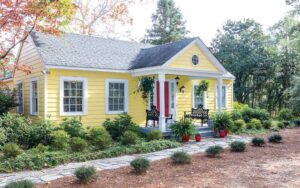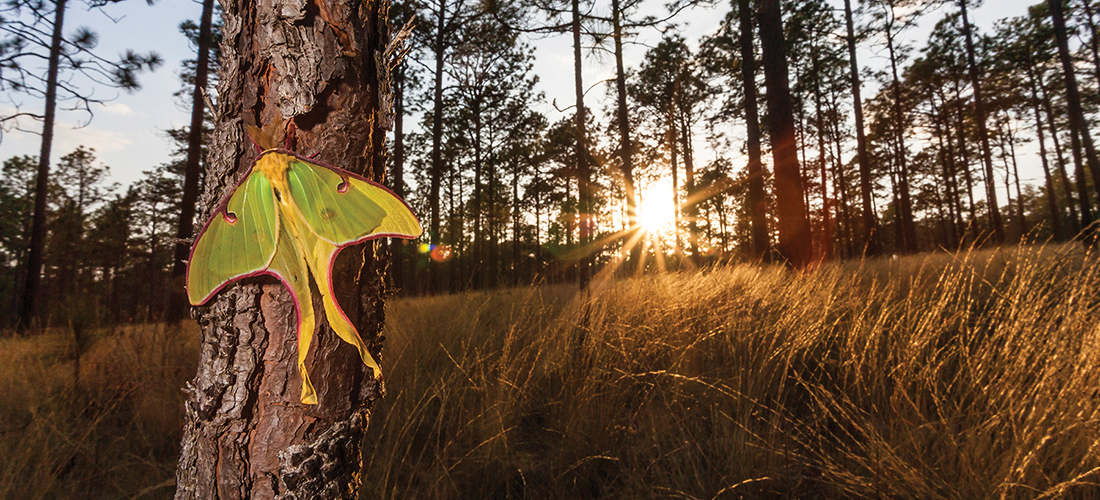
The roots of a massive ecosystem
By Bill Fields • Photographs by Brady Beck
For those who understand the longleaf pine, lose sleep over its well-being and know of its former ubiquity in the southeastern United States, there is a yearning to have witnessed the old landscape vastly different from today.
“Guys fantasize about a lot of things,” says Jesse Wimberley, outreach coordinator for the nonprofit Sandhills Area Land Trust, “but you’re talking to a guy who literally fantasizes about wanting to have seen that forest. I think we missed out on one of the greatest things that this country ever had — that endless longleaf forest that went on for miles and miles and miles.”
An Aberdeen native, 1976 Pinecrest High School graduate and fourth-generation longleaf farmer, Wimberley calls the 92 million acres of longleaf that once existed from Virginia south to Florida and west to Texas “the greatest ecosystem that ever existed in the United States.” It is hard to argue with him, especially in the Sandhills, where the species is the area’s long-needled fingerprint, the remnant that offers an inkling of what stood centuries earlier.
“They talked about being able to ride for days and days and never getting out of the piney woods,” says Robert Abernathy, president of the Longleaf Alliance, an education and advocacy organization started in 1995. “You can get a taste of that in Weymouth Woods and on the Walthour-Moss property. You can get out in the middle of it, and if you don’t listen to the traffic, you can get an idea of what the forest looked like 200 years ago.”
There are accounts of what that experience would have been like, from William Bartram’s writings near the end of the 18th century to Basil Hall’s book Travels in North America, in the Years 1827 and 28.
“For five hundred miles, at the least, we travelled, in different parts of the South, over a country of this description, almost every where consisting of sand, feebly held together by a short wiry grass, shaded by the endless forest,” Hall, a native of Edinburgh, Scotland, wrote. “I don’t know exactly what was the cause, but it was a long time before I got quite tired of the scenery of these pine barrens. There was something, I thought, very graceful in the millions upon millions of tall and slender columns, growing up in solitude, not crowded upon one another, but gradually appearing to come closer and closer, till they formed a compact mass, beyond which nothing was to be seen.”
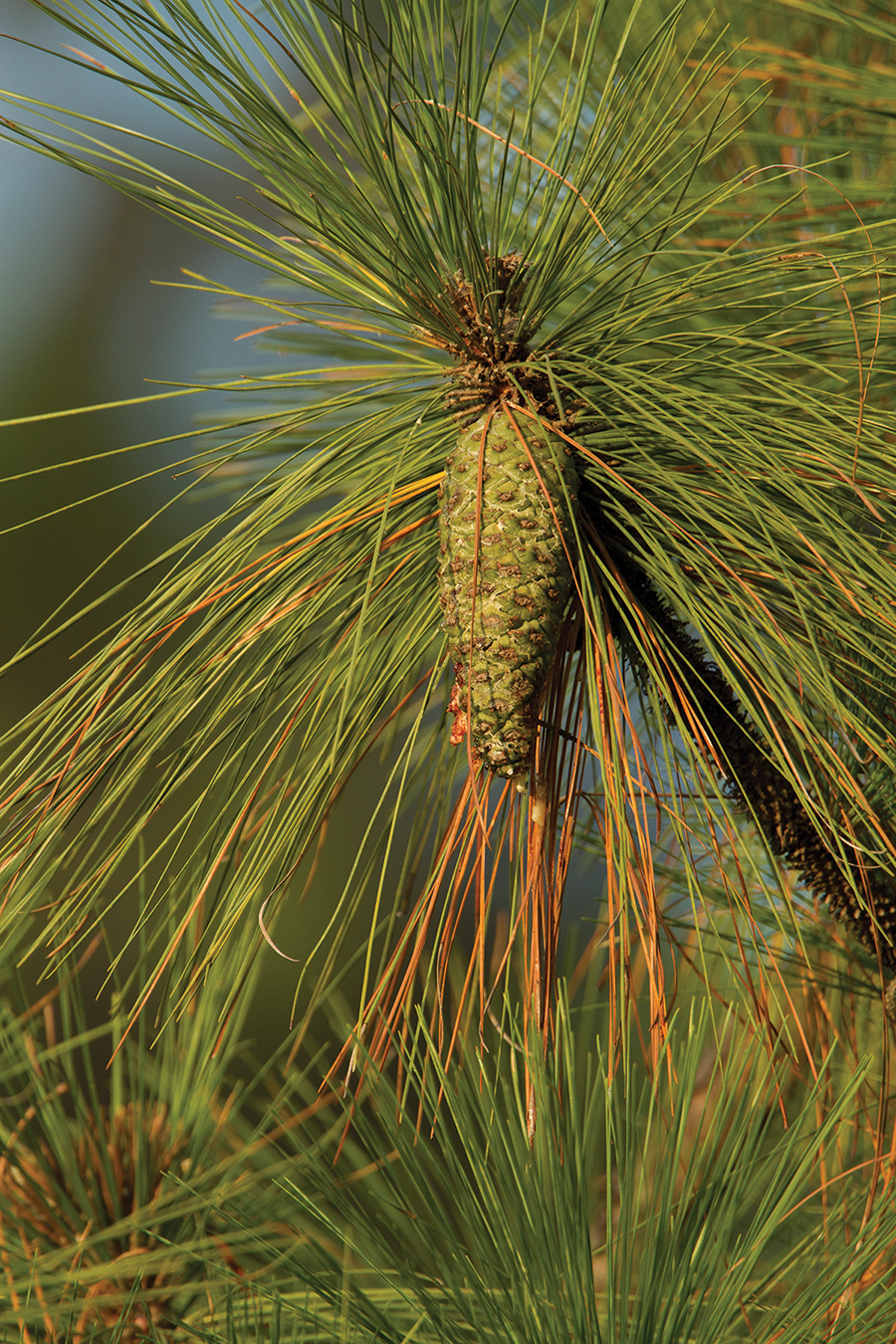
Traveling out through longleaf from Raleigh in 1853, a correspondent for The New York Times described “a soft winter’s day, when the evergreens filled the air with a balsamic odor, and the green light came quivering through them, and the foot fell silently upon the elastic carpet that had spread, deluding one with all the feelings of Spring.”
As John Patrick and James Walker Tufts arrived at the tail end of the 19th century in what became Southern Pines and Pinehurst, amid the detritus of a landscape savaged for timber and turpentine, it was the lung-clearing, life-affirming air among the remaining longleaf that gave the founders a reason to settle. On the early laps of the 21st century, as hastening development intrudes even on second-growth Sandhills longleaf, claiming them for shopping centers and tract homes, their scent and sight become something to savor ever more. Even what you hear, standing among longleaf “through which the wind roves with a sound no poet can capture,” as Hamlet native Tom Wicker wrote in 1975.
Given that only 4.7 million acres of longleaf pine forests stand today, 5 percent of its original geographic range — which was roughly the size of California — it would at first glance seem there isn’t much to cheer about. But things have gotten better since 1995 when a Journal of Forestry article titled “Requiem or Renaissance?” noted losses had reduced remaining longleaf forests to fewer than 3 million acres, a far more dramatic shrinkage than that suffered by the Amazon rainforest.
“It is progress, especially since we stopped the decline of the system itself,” says Dan Ryan of The Nature Conservancy, a longleaf specialist based in North Carolina. “It was on a horrific trajectory for a couple of hundred years. The fact that it’s actually increasing is phenomenal. But the ability to increase acreage is extremely resource-intensive because essentially there has to be protection over the land, and the habitat of the land needs to be managed for the longleaf pine. A lot of money is involved in turning that number around.”
When conservationists talk about restoring Pinus palustris, they are referring to much more than saving a small stand of the Sandhills’ signature tree, say, in the median of Midland Road — not that they wouldn’t want to do that, too. Naturalist John Muir wrote of his 1868 journey through the Southern piney woods that he “sauntered in delightful freedom.”
Muir’s experience was possible because of the essential character of a longleaf ecosystem, in which mature trees 70 to 120 feet tall (height primarily depends on the quality of the soil) tend to be void of low-hanging branches. The open canopy allows sunlight to reach the sandy forest floor, which in its natural state, thanks to periodic fire, is alive with grasses, wildflowers and wildlife.
“I like to tell people it’s the opposite of the rainforest,” says Nancy Williamson, park ranger at Weymouth Woods Sandhills Nature Preserve. “In the rainforest, it’s so dark on the forest floor there isn’t a lot of diversity on the floor. It’s the different kinds of trees and the things that are going on in them. With longleaf, the diversity is in the open understory.” Abernathy adds, “If you have the right plants, you have the animals, a whole suite of species.”
With the red-cockaded woodpecker — an endangered species that uses the trunk of a living longleaf for a nesting habitat — at home high above, the unique understory can be a haven for a host of other birds and mammals (approximately 30 species of each, including quail and fox squirrels) characteristic to a longleaf ecosystem. Beyond the birds and mammals is a diverse population, particularly in the Sandhills, of reptiles and amphibians. Abernathy cites as one of his favorites the legless glass lizard, which evades predators by dropping off part of its tail. “All these really cool animals most people don’t know about live in the longleaf ecosystem,” Abernathy says.
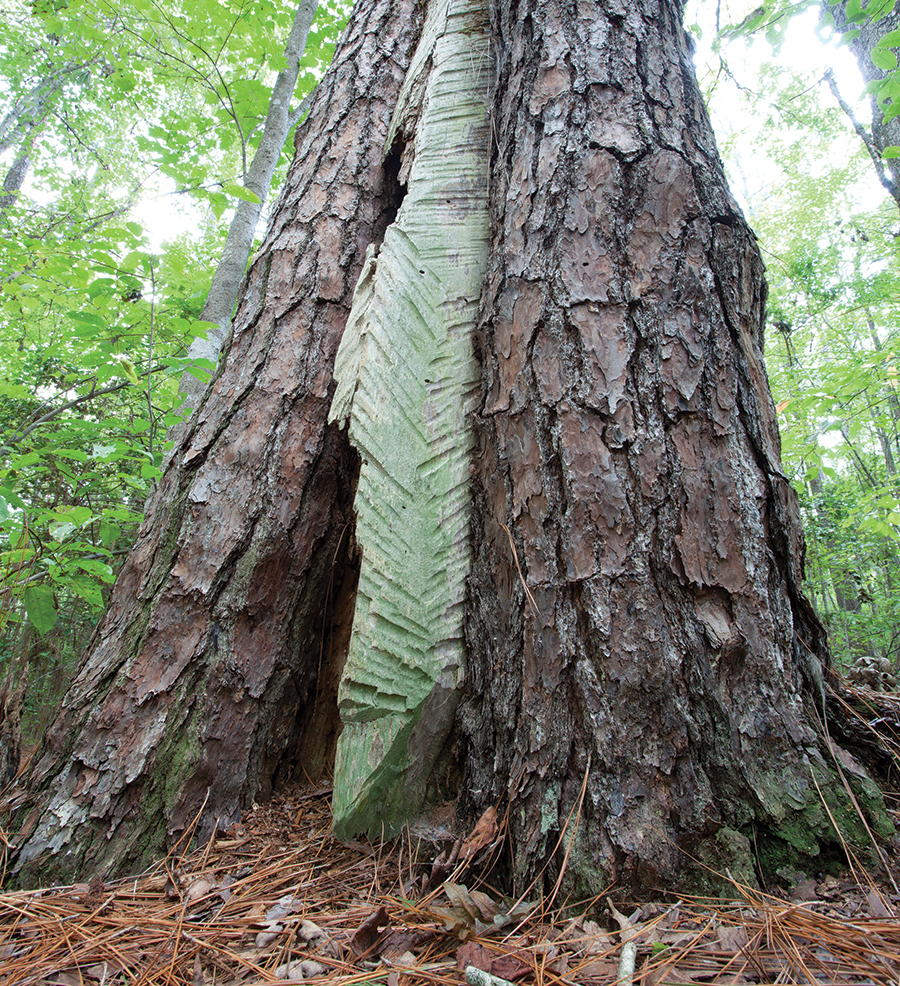
The many plants include wire grass, morning glory, blackberry, pawpaw, low-bush blueberry, orange-fringed orchids, dwarf iris, golden aster and bird’s foot violet. Writing in 1791, Bartram described “a forest of the great long-leaved pine, the earth covered with grass, interspersed with an infinite variety of herbaceous plants . . . ”
Generations of Americans grew up hearing from Smokey Bear about the dangers of forest fires. But well before the popular mascot was created in 1944, longleaf environments — and the living creatures and vegetation within that depend on fire to survive — were victims of this philosophy as surely as they were of the ax and the turpentine box.
“A lot of the fear of burning came out of the Northeast, where there were primarily hardwoods, which have a thinner bark than pines do,” Abernathy says. “They came and saw Southerners burning their trees and said, ‘Are you crazy?’”
As Helen G. Huttenhauer details in the history of her hometown, Young Southern Pines, James Boyd’s longleaf-rich property suffered a terrible fire after being misguided by federal forest officials to clear thin strips on his land for fire defense rather than regularly singeing the forest with prescribed burns that locals knew to be the correct approach. “Woods are going to burn,” Wimberley says. “Either we burn them or they are going to burn on their own.”
In the spring of 1909 a spark from a passing locomotive started a small brush fire that moved up Vermont Avenue to Weymouth. “The wind rose and carried sparks and the sparks fell on wire grass and started new fires,” Huttenhauer writes. “The firefighters stood transfixed. Suddenly, a vast wave of flame surged high over the tree tops and, borne by the wind, in seconds outdistanced the ground fire . . . A goodly portion of Boyd timberland lay in smoking ruins.”
Another scary fire started in Pinebluff in the spring of 1963, destroying homes and 3,000 acres as it moved toward Pinehurst, its flames traveling through the forest canopy and spreading 10 miles in less than four hours, according to an Associated Press report.
Longleaf withstands routine fires well, one of the reasons it came to dominate the Southeastern landscape, primarily because of its thick and tough bark described by author Bill Finch in Longleaf, Far as the Eye Can See “as layered as a Greek pastry.” Lawrence S. Earley, whose 2004 book Looking for Longleaf: The Fall and Rise of an American Forest provides a definitive look at the tree’s past and present, noted its formidable barrier.
“As a fire licks the bark of a tree, the temperature on the surface can rise to 1,600 degrees Fahrenheit,” Earley writes. “At a temperature of 140 degrees Fahrenheit, the cambium of a tree is killed. Thus bark can be considered the Maginot Line of a tree’s fire defenses.”
Combined with an unusually strong taproot, longleaf’s fire resistance contributes to its longevity. Although far from being the longest-living tree — a Great Basin bristlecone pine in the White Mountains of California is 5,066 years old, and giant sequoia have been verified at a few thousand years old — a longleaf’s lifespan can exceed more than 500 years. That’s about twice as long, for example, as live oak, pecan or American elm.
The oldest recorded living longleaf, situated off Den Road on the Boyd tract in Weymouth Woods, dates to 1548, its age determined a decade ago by a UNC Greensboro graduate student, Jason Ortegren, and his geography professor, Paul Knapp, who cored it for a historical climate study. That makes it 469 years old, having come to life 59 years before the founding of Jamestown, 228 years before the Declaration of Independence, 317 years before the end of the Civil War and 431 years before the state park acquired the 105-acre Boyd tract populated by old-growth longleaf James Boyd saved from the jaws of commerce when he bought his estate. The ancient pine is approximately 75 feet tall and 2 feet in diameter, its bark bulging in places like the arthritic knuckles of a senior citizen.
“The Boyd tract was never timbered and is mostly old-growth,” Williamson says. “A lot of the trees there are probably 400 years old. There could be older trees — we definitely have ones that are larger than the one that was measured. It may be even be a little bit older than 469 because when longleaf start out they’re in a grass stage for a couple of years. Whatever its exact age, every time we get a storm, we get nervous. Hurricane Matthew last fall made us hold our breath a little bit.”
Most of the longleaf that emerged in the 16th century were harvested long ago. The species was used for naval stores, goods for building and maintaining ships, from wood to various products made from the sap. Turpentine distillation accelerated prior to 1840, and later in the 19th century the advent of railroad lines and steam-powered sawmills led to the decimation of much of the virgin longleaf forest over a 50-year period following the Civil War. By 1955 only about one-eighth of the original longleaf forest was left. With longleaf being abandoned for faster-growing loblolly pine by many logging concerns — loblolly yields saw timber in 40 to 50 years versus 50 to 70 for longleaf — the longleaf acreage had decreased to about 4 million in 1985.
There was no secret why mature longleaf — dense, strong and pest-resistant because of its high resin content and slow growth — was so desirable. “It’s impervious to just about anything,” says Bennett Rose, a retired forester in Southern Pines. “A termite would break his beak trying to get through that stuff.”
Before techniques were invented to propel the modern steel industry in the second half of the 19th century, longleaf was the most valuable construction material. “Everybody in the wood business says the longleaf pine was the best wood the Lord ever made,” antique pine dealer Pat Fontenot told The New York Times in 2015. “If it wouldn’t have been for the longleaf pine tree, we wouldn’t have been able to do the Industrial Revolution.”
Much of the old-growth longleaf, centuries old, went north, for buildings and bridges (including underwater support for the base of the Brooklyn Bridge, built in 1883). Reclaimed longleaf has become a hot business in recent years as architects seek to use it for a vintage look. Bill Gingerich, owner of Timber Services, Inc., in Carthage, specializes in longleaf lumber and flooring. He buys old buildings and salvages the wood and also cuts down trees on private land that have to come out for construction.
Not long ago Gingerich bought big longleaf timbers that came from a building in rural North Carolina and was amazed when he studied the wood, suspecting it could 600 years old. “The growth rings on some of the beams are like pieces of paper,” he says. “It’s crazy old.”
But the longleaf that he cuts down doesn’t have to be quite that old. “We’ve learned that in order for longleaf to have good heart, which is what we make our flooring out of, it needs to be at least 80 years old,” Gingerich says. “We’re still finding those type trees and even older ones. We’ve seen some that were 150, 160 years old. Heart pine that old makes a beautiful floor. But an 80-year-old tree can be just as beautiful as an old-growth one.”
Longleaf advocates, who have an ambitious goal of increasing the longleaf environment to 8 million acres by 2025, spend their time educating and arm-twisting as they try to increase longleaf’s presence on private property. “We’ve done a good job restoring it on public lands,” Wimberley says. “Now the effort is on restoring it on private lands. Sixty percent of the potential longleaf restoration is on private land.” That potential could have economic as well as environmental effects.
“Rural eastern North Carolina has been devastated by the loss of tobacco and manufacturing,” Wimberley says. “It’s heartbreaking to see how hollowed out some of these towns are. We believe longleaf could be a game-changer that helps a landowner retain his land and see a profit from growing longleaf.”
It can be a tough sell, given the slower growth of longleaf compared to loblolly and the longer time frame before timber can be harvested. The distinctive, long needles and their landscaping popularity has turned pine straw into a financial winner, with property owners getting $100 to $200 an acre annually once trees start yielding straw at about a dozen years old. Yet that proposition is not without environmental trade-offs.
“Straw can be a lucrative thing in a place like the Sandhills,” says Ryan Bollinger, who works in Southern Pines for the Longleaf Alliance. “But if you rake really hard, you’re essentially doing commercial timber with longleaf pines, you’re basically creating an ecological desert under your longleaf when there is no understory. When you rake too hard for a number of years, then there is no food for the critters, and the rare plants and things get pushed out.”
Bollinger likes to preach “rake, rest, burn” to landowners, urging them not to rake every year. Or, if someone has a large property, a portion of it can be used for pine straw and the rest left undisturbed other than for prescribed burns.
“Landowners who are growing longleaf aren’t trying to make the most money possible on their property,” Abernathy says. “They want an income. But they want to ride their horses through that property. They want to hunt quail and deer. They want the look.”
They want a version of what a “magnificent grove of stately pines” brought to William Bartram more than two centuries ago, “a pleasing effect, rousing the faculties of the mind, awakening the imagination by its sublimity, and arresting every active inquisitive idea, by the variety of the scenery and the solemn symphony of the steady Western breezes, playing incessantly, rising and falling through the thick and wavy foliage.” PS
Longleaf Pine Celebrations
The Party for the Pine, an annual celebration for the oldest longleaf pine, will take place on Earth Day, April 22, from 10 a.m. to 3 p.m. Festivities begin in the meadow behind the Weymouth Center, 555 E. Connecticut Avenue, Southern Pines. It’s sponsored by Weymouth Woods-Sandhills Nature Preserve, Sandhills Area Land Trust, the Arts Council of Moore County, the Sunrise Theater and is funded in part by the Renewable Resources Extension Act. Haw River-based singer-songwriter and guitarist Bill West will kick off the music, followed by Cousin Amy Deluxe Old Time String Band taking the stage at 11 a.m. Band members Amy McDonald, David McDonald, Steven Hedgpeth, Rob Shanana and Allen Ashdown transport the audience back in time with their Appalachian fiddle dance music. Abigail Dowd will be joined by Michael Gaffney and Jason Duff at 1:30 p.m. Gaffney, who grew up in the Sandhills, was a fixture in the Asheville music scene for over 35 years. There will also be a guided hike to the oldest tree, a falconry presentation by Hawk Manor Falconry, a birthday celebration and a live prescribed burn.
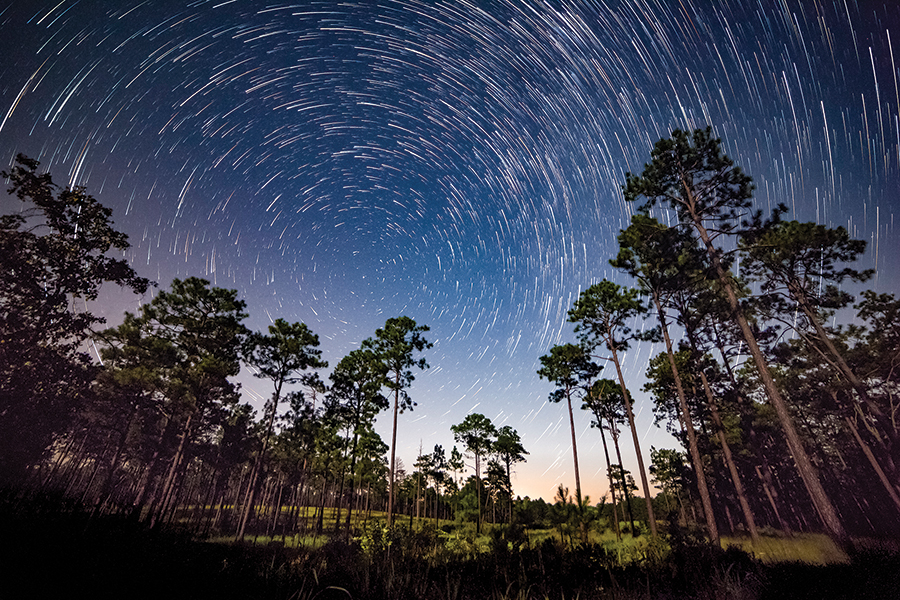
The movie Siren of the Round Timber Tract, by Brady Beck and Ray Owen, will debut at 5:30 p.m. at the Sunrise Theater, 250 NW Broad Street, Southern Pines. Admission is free and doors open at 5 p.m. The film is a dramatic work telling the story of the Round Timber tract, the most ancient part of Weymouth Woods Preserve. The saving of this section of forest effectively launched longleaf pine conservation throughout the Southeast. The film will be preceded by guest speaker Janisse Ray, writer, activist and naturalist who has authored six books, including her memoir, Ecology of a Cracker Childhood. She was a 2015 inductee into the Georgia Writers Hall of Fame.
A Star Party, the fifth annual event and part of the N.C. Science Festival, takes place the evening of April 22. Bring blankets and lawn chairs and meet at the parking lot of the Weymouth Center at 555 E. Connecticut Ave. Activities, prepared by the statewide organizer, typically include stargazing, locating common constellations, a small telescope for viewing planets or the moon and kid-friendly crafts. PS



